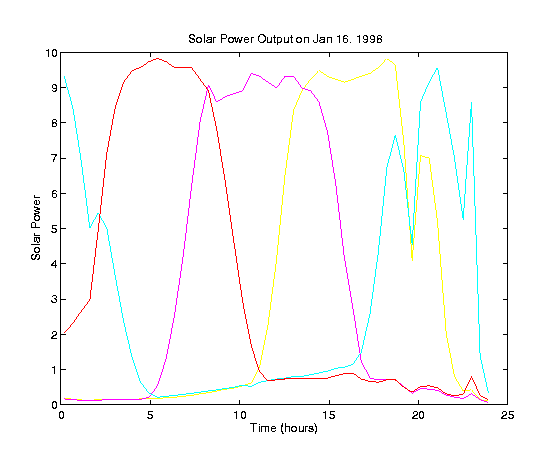
Solar Experiment

Setup
The solar experiment consisted of 4 Siemens 10W solar panels. The output
of the solar panels was applied to one of two resistive loads or a battery.
The battery was used to power a microcontroller which recorded the voltage
generated by the solar panels across the resistive loads. The tempera ture
was also recorded. Each solar panel was mounted facing a perpendicular
direction. To reduce wind loading the panel was deployed facing approximately
NW. The others faced NE, SE and SW. Data was sampled every 2 min and the
average recorded every 30min, 24 hours a day.
Results
There was no observed snow accumulation of the solar panels. This is due
to the hard, granular nature of the snow as well as the steep angle of
the panels.
The following average power outputs were recorded under low resistance
and high resistance loads:
|
Average Solar Power
|
|
Low Resistance Load
|
High Resistance Load
|
| Average Maximum Power |
6.3 W |
| Average Minimum Power |
0.6 W |
|
| Average Maximum Power |
4.6 W |
| Average Minimum Power |
1.1 W |
|
|
Maximum power is generated when the panel is facing the sun, while
minimum power is generated when the panel is facing away from the sun (lit
only by reflection of surrounding snow). On average only 1/2 of the panel's
rated power was generated.
The average temperatures recorded were:
|
Average Temperature
|
| External Temp |
-3.7 C |
| Internal Temp |
15.9 C |
|
The battery never needed external charging, despite operating continually
for 20 days. This indicates that the solar panels produced enough power
to keep it charged (the entire monitoring circuit used 2.2W continuously)

This shows the power output of all four solar panels over 24 hours.
Notice that the output of each panel is roughly sinusoidal indicating the
dependence on Sun angle to power output as the Sun clocks around the experiment.
Conclusions
The temperatures seen during the experiment were significantly warmer than
the -20 C expected and designed for. The solar panels only produced 60%
of rated output on the average. Peak powers of 10 or 11W were common. The
average was brought down due to several days of cloudy weather. However,
this provides a conservative bound of 60W/m2 of solar panels, instead of
the 100W/m2 which the panel specifications would indicate. Reflectance
from snow, while small, could contribute a few watts per square meter of
solar panel. The snow in the Patriot Hills region was very granular, almost
ice crystals. This is probably due to the dryness rather than cold temperatures.
However, it did not stick to the solar panels at all, even though a few
blizzards occurred during the experiment.
 |
Robotic Search for Antarctic Meteorites 1997
All material on this page is property of NASA and Carnegie
Mellon University. Any image or text taken from this site and pasted
into any other document without consent violates the Copyright Law of
the United States and the Berne International Copyright Agreement.
Send comments, questions, or suggestions to:
meteorite-info@ri.cmu.edu
This document prepared by
Matthew Deans
|
 |



